sensor MITSUBISHI OUTLANDER PHEV 2016 (in English) Service Manual
[x] Cancel search | Manufacturer: MITSUBISHI, Model Year: 2016, Model line: OUTLANDER PHEV, Model: MITSUBISHI OUTLANDER PHEV 2016Pages: 490, PDF Size: 22.02 MB
Page 284 of 490
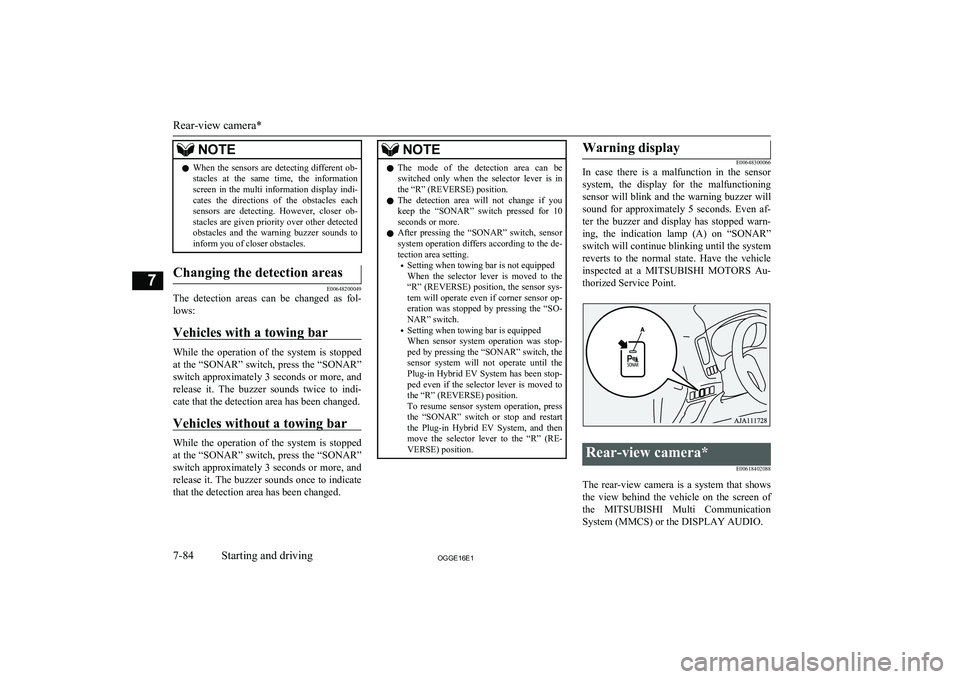
NOTElWhen the sensors are detecting different ob-
stacles at the same time, the information screen in the multi information display indi-
cates the directions of the obstacles each sensors are detecting. However, closer ob-
stacles are given priority over other detected obstacles and the warning buzzer sounds to
inform you of closer obstacles.Changing the detection areas
E00648200049
The detection areas can be changed as fol-
lows:
Vehicles with a towing bar
While the operation of the system is stopped
at the “SONAR” switch, press the “SONAR”
switch approximately 3 seconds or more, and release it. The buzzer sounds twice to indi-
cate that the detection area has been changed.
Vehicles without a towing bar
While the operation of the system is stopped
at the “SONAR” switch, press the “SONAR”
switch approximately 3 seconds or more, and
release it. The buzzer sounds once to indicate that the detection area has been changed.
NOTEl The mode of the detection area can be
switched only when the selector lever is inthe “R” (REVERSE) position.
l The detection area will not change if you
keep the “SONAR” switch pressed for 10
seconds or more.
l After pressing the “SONAR” switch, sensor
system operation differs according to the de- tection area setting.
• Setting when towing bar is not equipped
When the selector lever is moved to the “R” (REVERSE) position, the sensor sys-
tem will operate even if corner sensor op-
eration was stopped by pressing the “SO-
NAR” switch.
• Setting when towing bar is equipped
When sensor system operation was stop-
ped by pressing the “SONAR” switch, the sensor system will not operate until the
Plug-in Hybrid EV System has been stop-
ped even if the selector lever is moved to the “R” (REVERSE) position.
To resume sensor system operation, press
the “SONAR” switch or stop and restart
the Plug-in Hybrid EV System, and then move the selector lever to the “R” (RE-
VERSE) position.Warning display
E00648300066
In case there is a malfunction in the sensor
system, the display for the malfunctioning
sensor will blink and the warning buzzer will
sound for approximately 5 seconds. Even af-ter the buzzer and display has stopped warn-
ing, the indication lamp (A) on “SONAR” switch will continue blinking until the system reverts to the normal state. Have the vehicle
inspected at a MITSUBISHI MOTORS Au-
thorized Service Point.Rear-view camera*
E00618402088
The rear-view camera is a system that showsthe view behind the vehicle on the screen of
the MITSUBISHI Multi Communication
System (MMCS) or the DISPLAY AUDIO.
Rear-view camera*
7-84OGGE16E1Starting and driving7
Page 306 of 490
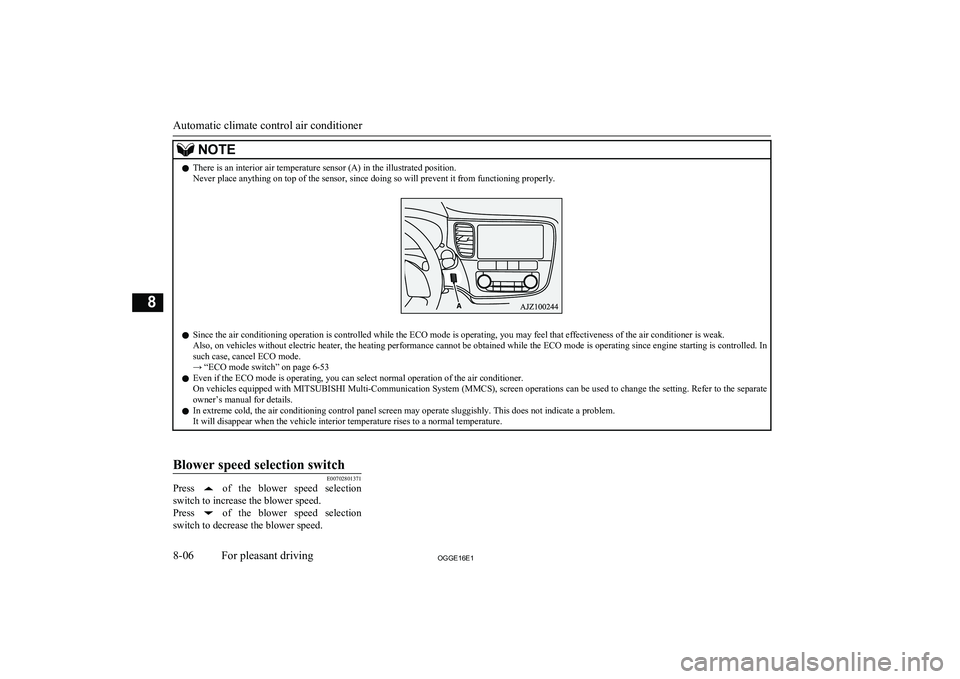
NOTElThere is an interior air temperature sensor (A) in the illustrated position.
Never place anything on top of the sensor, since doing so will prevent it from functioning properly.
l Since the air conditioning operation is controlled while the ECO mode is operating, you may feel that effectiveness of the air conditioner is weak.
Also, on vehicles without electric heater, the heating performance cannot be obtained while the ECO mode is operating since engine starting is controlled. In such case, cancel ECO mode.
→ “ECO mode switch” on page 6-53
l Even if the ECO mode is operating, you can select normal operation of the air conditioner.
On vehicles equipped with MITSUBISHI Multi-Communication System (MMCS), screen operations can be used to change the setting. Refer to the separate
owner’s manual for details.
l In extreme cold, the air conditioning control panel screen may operate sluggishly. This does not indicate a problem.
It will disappear when the vehicle interior temperature rises to a normal temperature.
Blower speed selection switch
E00702801371
Press of the blower speed selection
switch to increase the blower speed.
Press
of the blower speed selection
switch to decrease the blower speed.
Automatic climate control air conditioner
8-06OGGE16E1For pleasant driving8
Page 392 of 490
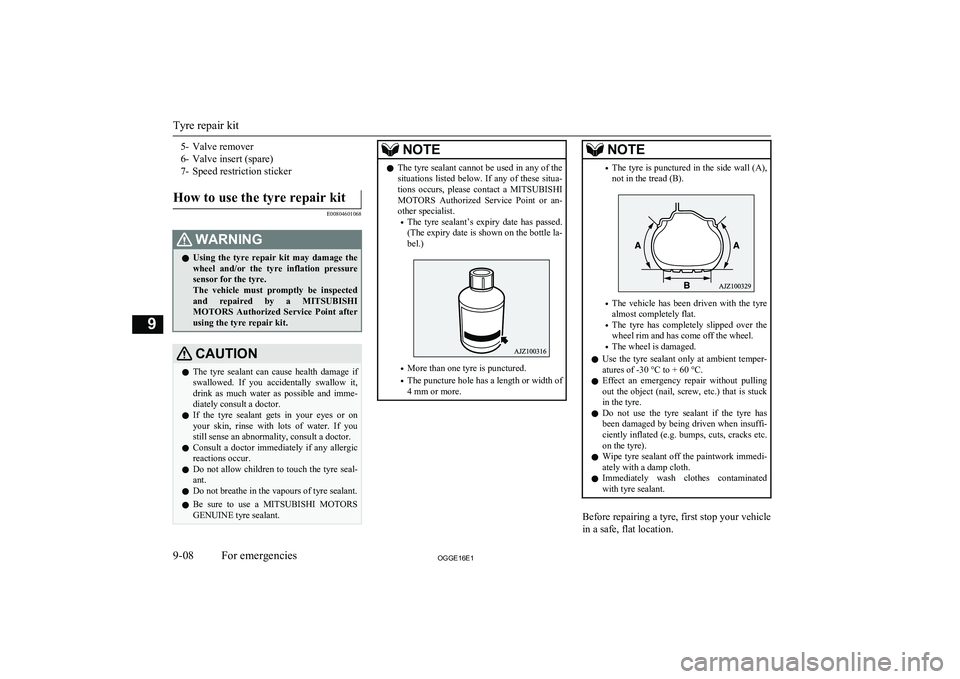
5- Valve remover
6- Valve insert (spare)
7- Speed restriction stickerHow to use the tyre repair kit
E00804601068
WARNINGl Using the tyre repair kit may damage the
wheel and/or the tyre inflation pressure
sensor for the tyre.
The vehicle must promptly be inspected and repaired by a MITSUBISHI
MOTORS Authorized Service Point after
using the tyre repair kit.CAUTIONl The tyre sealant can cause health damage if
swallowed. If you accidentally swallow it,
drink as much water as possible and imme-
diately consult a doctor.
l If the tyre sealant gets in your eyes or on
your skin, rinse with lots of water. If you still sense an abnormality, consult a doctor.
l Consult a doctor immediately if any allergic
reactions occur.
l Do not allow children to touch the tyre seal-
ant.
l Do not breathe in the vapours of tyre sealant.
l Be sure to use a
MITSUBISHI MOTORS
GENUINE tyre sealant.NOTEl The tyre sealant cannot be used in any of the
situations listed below. If any of these situa-
tions occurs, please contact a MITSUBISHI
MOTORS Authorized Service Point or an-
other specialist.
• The tyre sealant’s expiry date has passed.
(The expiry date is shown on the bottle la- bel.)
• More than one tyre is punctured.
• The puncture hole has a length or width of
4 mm or more.
NOTE• The tyre is punctured in the side wall (A),
not in the tread (B).
• The vehicle has been driven with the tyre
almost completely flat.
• The tyre has completely slipped over the
wheel rim and has come off the wheel.
• The wheel is damaged.
l Use the tyre sealant only at ambient temper-
atures of -30 °C to + 60 °C.
l Effect an emergency repair without pulling
out the object (nail, screw, etc.) that is stuck
in the tyre.
l Do not use the tyre sealant if the tyre has
been damaged by being driven when insuffi- ciently inflated (e.g. bumps, cuts, cracks etc.
on the tyre).
l Wipe tyre sealant off the paintwork immedi-
ately with a damp cloth.
l Immediately wash clothes contaminated
with tyre sealant.
Before repairing a tyre, first stop your vehicle
in a safe, flat location.
Tyre repair kit
9-08OGGE16E1For emergencies9
Page 412 of 490
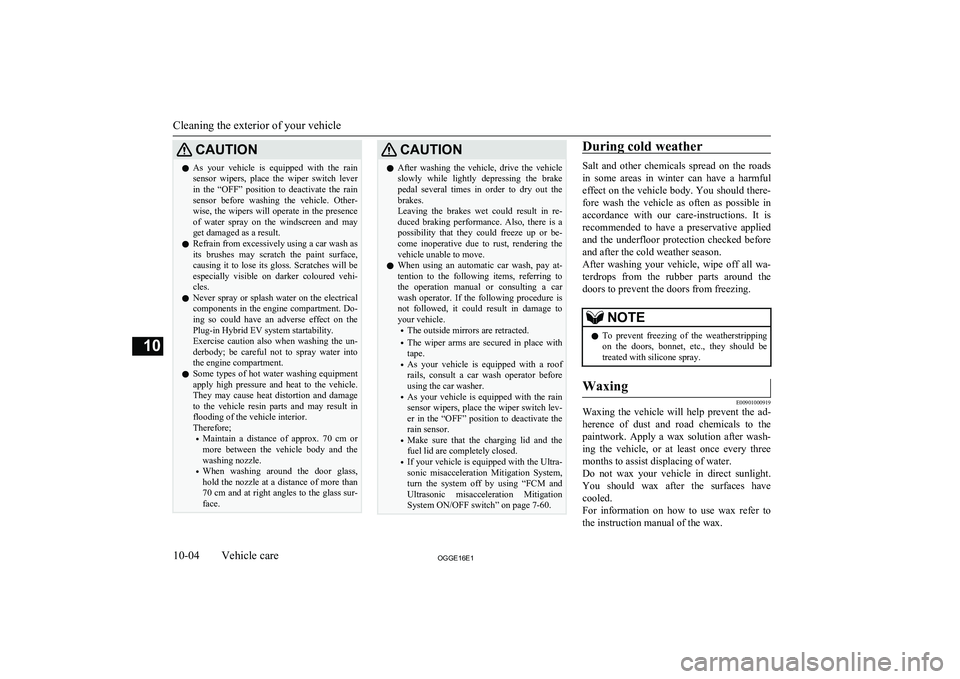
CAUTIONlAs your vehicle is equipped with the rain
sensor wipers, place the wiper switch lever
in the “OFF” position to deactivate the rain
sensor before washing the vehicle. Other- wise, the wipers will operate in the presenceof water spray on the windscreen and may
get damaged as a result.
l Refrain from excessively using a car wash as
its brushes may scratch the paint surface,
causing it to lose its gloss. Scratches will be
especially visible on darker coloured vehi-
cles.
l Never spray or splash water on the electrical
components in the engine compartment. Do- ing so could have an adverse effect on the
Plug-in Hybrid EV system startability.
Exercise caution also when washing the un-
derbody; be careful not to spray water into the engine compartment.
l Some types of hot water washing equipment
apply high pressure and heat to the vehicle. They may cause heat distortion and damage
to the vehicle resin parts and may result in flooding of the vehicle interior.
Therefore;
• Maintain a distance of approx. 70 cm or
more between the vehicle body and the washing nozzle.
• When washing around the door glass,
hold the nozzle at a distance of more than
70 cm and at right angles to the glass sur- face.CAUTIONl After washing the vehicle, drive the vehicle
slowly while lightly depressing the brake
pedal several times in order to dry out the
brakes.
Leaving the brakes wet could result in re- duced braking performance. Also, there is a possibility that they could freeze up or be-
come inoperative due to rust, rendering the vehicle unable to move.
l When using an automatic car wash, pay at-
tention to the following items, referring to the operation manual or consulting a car
wash operator. If the following procedure is not followed, it could result in damage to
your vehicle.
• The outside mirrors are retracted.
• The wiper arms are secured in place with
tape.
• As your vehicle is equipped with a roof
rails, consult a car wash operator before using the car washer.
• As your vehicle is equipped with the rain
sensor wipers, place the wiper switch lev- er in the “OFF” position to deactivate the
rain sensor.
• Make sure that the charging lid and the
fuel lid are completely closed.
• If your vehicle is equipped with the Ultra-
sonic misacceleration Mitigation System, turn the system off by using “FCM and
Ultrasonic misacceleration Mitigation
System ON/OFF switch” on page 7-60.During cold weather
Salt and other chemicals spread on the roads
in some areas in winter can have a harmful effect on the vehicle body. You should there-
fore wash the vehicle as often as possible in accordance with our care-instructions. It is
recommended to have a preservative applied
and the underfloor protection checked before and after the cold weather season.
After washing your vehicle, wipe off all wa- terdrops from the rubber parts around the
doors to prevent the doors from freezing.
NOTEl To prevent freezing of the weatherstripping
on the doors, bonnet, etc., they should be treated with silicone spray.Waxing
E00901000919
Waxing the vehicle will help prevent the ad-
herence of dust and road chemicals to the paintwork. Apply a wax solution after wash- ing the vehicle, or at least once every three
months to assist displacing of water.
Do not wax your vehicle in direct sunlight.
You should wax after the surfaces have
cooled.
For information on how to use wax refer to the instruction manual of the wax.
Cleaning the exterior of your vehicle
10-04OGGE16E1Vehicle care10
Page 425 of 490
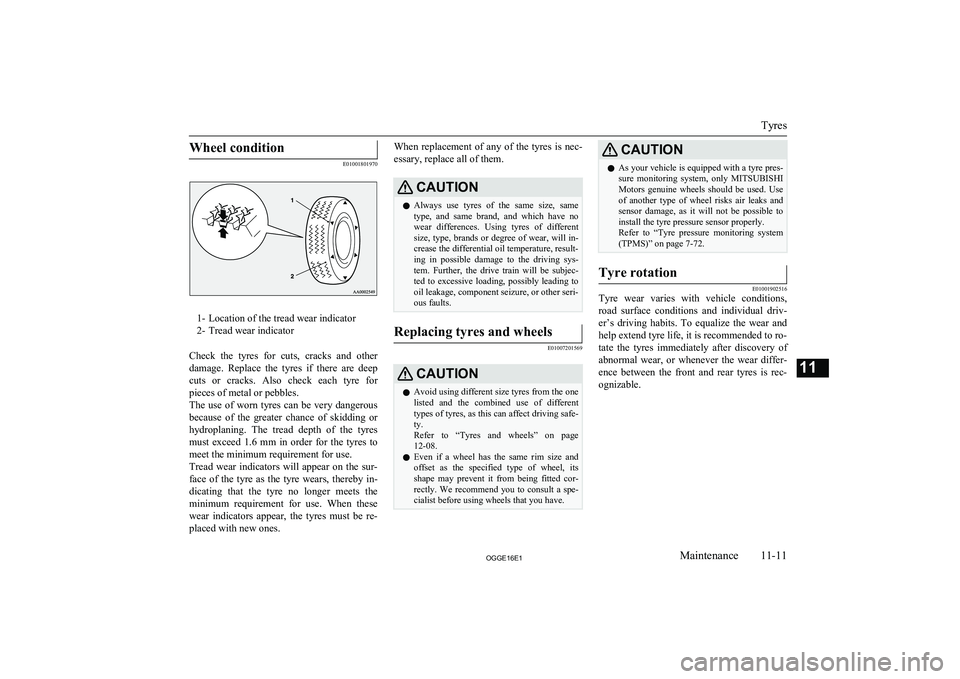
Wheel condition
E01001801970
1- Location of the tread wear indicator
2- Tread wear indicator
Check the tyres for cuts, cracks and other damage. Replace the tyres if there are deep
cuts or cracks. Also check each tyre for pieces of metal or pebbles.
The use of worn tyres can be very dangerous
because of the greater chance of skidding or
hydroplaning. The tread depth of the tyres
must exceed 1.6 mm in order for the tyres to meet the minimum requirement for use.
Tread wear indicators will appear on the sur-
face of the tyre as the tyre wears, thereby in-
dicating that the tyre no longer meets the
minimum requirement for use. When these wear indicators appear, the tyres must be re-
placed with new ones.
When replacement of any of the tyres is nec-
essary, replace all of them.CAUTIONl Always use tyres of the same size, same
type, and same brand, and which have no wear differences. Using tyres of differentsize, type, brands or degree of wear, will in-
crease the differential oil temperature, result-
ing in possible damage to the driving sys-
tem. Further, the drive train will be subjec- ted to excessive loading, possibly leading tooil leakage, component seizure, or other seri-
ous faults.Replacing tyres and wheels
E01007201569
CAUTIONl Avoid using different size tyres from the one
listed and the combined use of different
types of tyres, as this can affect driving safe- ty.
Refer to “Tyres and wheels” on page
12-08.
l Even if a wheel has the same rim size and
offset as the specified type of wheel, its
shape may prevent it from being fitted cor- rectly. We recommend you to consult a spe-
cialist before using wheels that you have.CAUTIONl As your vehicle is equipped with a tyre pres-
sure monitoring system, only MITSUBISHI
Motors genuine wheels should be used. Use
of another type of wheel risks air leaks and
sensor damage, as it will not be possible to install the tyre pressure sensor properly.
Refer to “Tyre pressure monitoring system
(TPMS)” on page 7-72.Tyre rotation
E01001902516
Tyre wear varies with vehicle conditions,
road surface conditions and individual driv- er’s driving habits. To equalize the wear andhelp extend tyre life, it is recommended to ro-
tate the tyres immediately after discovery of
abnormal wear, or whenever the wear differ- ence between the front and rear tyres is rec-
ognizable.
Tyres
11-11OGGE16E1Maintenance11
Page 426 of 490
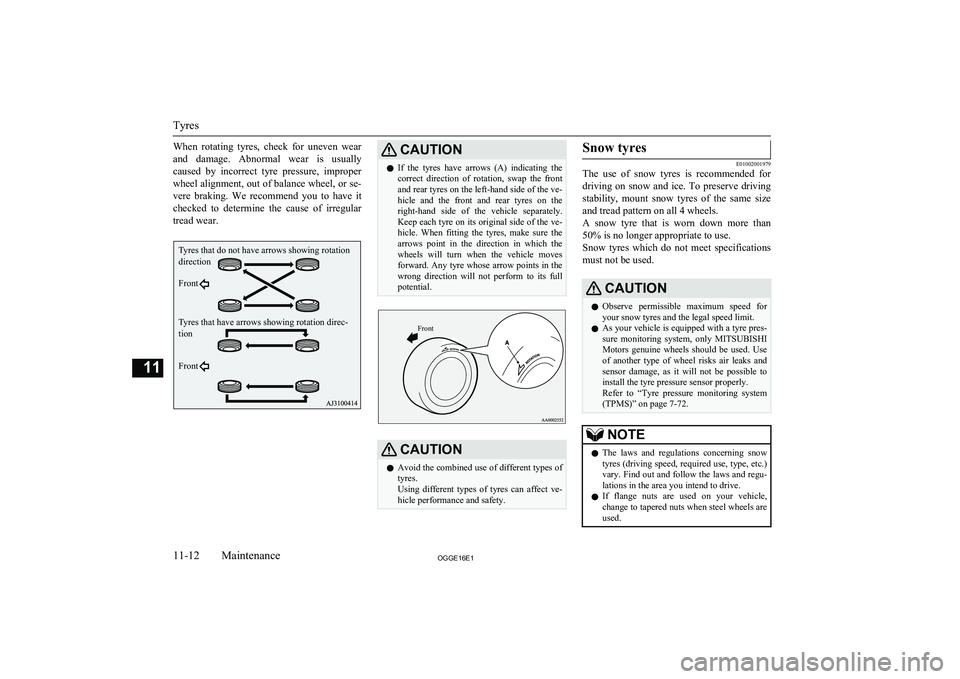
When rotating tyres, check for uneven wear
and damage. Abnormal wear is usually caused by incorrect tyre pressure, improper wheel alignment, out of balance wheel, or se-
vere braking. We recommend you to have it checked to determine the cause of irregular
tread wear.CAUTIONl If the tyres have arrows (A) indicating the
correct direction of rotation, swap the front
and rear tyres on the left-hand side of the ve- hicle and the front and rear tyres on the right-hand side of the vehicle separately.
Keep each tyre on its original side of the ve- hicle. When fitting the tyres, make sure the
arrows point in the direction in which the wheels will turn when the vehicle moves
forward. Any tyre whose arrow points in the wrong direction will not perform to its fullpotential.Front
CAUTIONl Avoid the combined use of different types of
tyres.
Using different types of tyres can affect ve-
hicle performance and safety.Snow tyres
E01002001979
The use of snow tyres is recommended for
driving on snow and ice. To preserve driving stability, mount snow tyres of the same size and tread pattern on all 4 wheels.
A snow tyre that is worn down more than
50% is no longer appropriate to use.
Snow tyres which do not meet specifications must not be used.
CAUTIONl Observe permissible maximum speed for
your snow tyres and the legal speed limit.
l As your vehicle is equipped with a tyre pres-
sure monitoring system, only MITSUBISHI
Motors genuine wheels should be used. Use
of another type of wheel risks air leaks and
sensor damage, as it will not be possible to install the tyre pressure sensor properly.
Refer to “Tyre pressure monitoring system
(TPMS)” on page 7-72.NOTEl The laws and regulations concerning snow
tyres (driving speed, required use, type, etc.)
vary. Find out and follow the laws and regu- lations in the area you intend to drive.
l If flange nuts are used on your vehicle,
change to tapered nuts when steel wheels are used.
Tyres
11-12OGGE16E1Maintenance11Tyres that do not have arrows showing rotation direction Front
Tyres that have arrows showing rotation direc- tion Front
Page 457 of 490
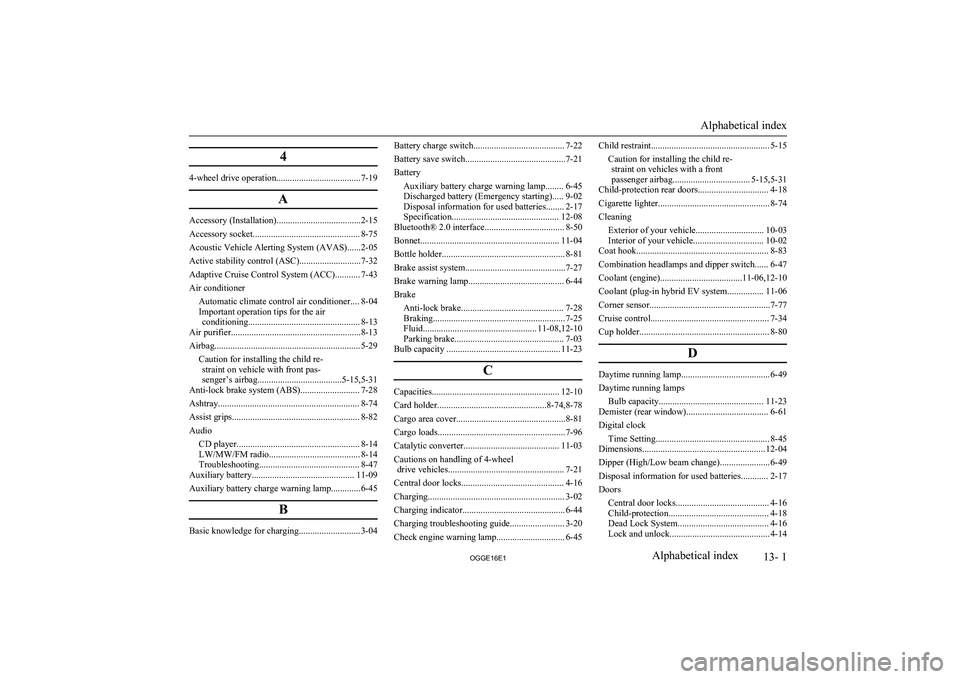
4
4-wheel drive operation.....................................7-19A
Accessory (Installation).....................................2-15
Accessory socket............................................... 8-75
Acoustic Vehicle Alerting System (AVAS)......2-05
Active stability control (ASC)...........................7-32
Adaptive Cruise Control System (ACC)........... 7-43
Air conditioner Automatic climate control air conditioner.... 8-04
Important operation tips for the air conditioning................................................. 8-13
Air purifier.........................................................8-13
Airbag................................................................ 5-29 Caution for installing the child re-straint on vehicle with front pas-
senger’s airbag.....................................5-15,5-31
Anti-lock brake system (ABS).......................... 7-28
Ashtray.............................................................. 8-74
Assist grips........................................................ 8-82
Audio
CD player...................................................... 8-14
LW/MW/FM radio........................................ 8-14
Troubleshooting............................................ 8-47
Auxiliary battery............................................. 11-09
Auxiliary battery charge warning lamp.............6-45
B
Basic knowledge for charging........................... 3-04
Battery charge switch........................................ 7-22
Battery save switch............................................7-21
Battery Auxiliary battery charge warning lamp........ 6-45
Discharged battery (Emergency starting)..... 9-02
Disposal information for used batteries........ 2-17 Specification............................................... 12-08
Bluetooth® 2.0 interface................................... 8-50
Bonnet............................................................. 11-04
Bottle holder...................................................... 8-81
Brake assist system............................................7-27
Brake warning lamp.......................................... 6-44
Brake Anti-lock brake............................................. 7-28
Braking.......................................................... 7-25
Fluid.................................................. 11-08,12-10
Parking brake................................................ 7-03
Bulb capacity .................................................. 11-23
C
Capacities........................................................ 12-10
Card holder................................................8-74,8-78
Cargo area cover................................................8-81
Cargo loads........................................................7-96
Catalytic converter.......................................... 11-03
Cautions on handling of 4-wheel drive vehicles................................................... 7-21
Central door locks............................................. 4-16
Charging............................................................ 3-02
Charging indicator............................................. 6-44
Charging troubleshooting guide........................ 3-20
Check engine warning lamp.............................. 6-45
Child restraint.................................................... 5-15 Caution for installing the child re-straint on vehicles with a front
passenger airbag.................................. 5-15,5-31
Child-protection rear doors............................... 4-18
Cigarette lighter................................................. 8-74
Cleaning
Exterior of your vehicle.............................. 10-03Interior of your vehicle............................... 10-02
Coat hook.......................................................... 8-83
Combination headlamps and dipper switch...... 6-47
Coolant (engine)....................................11-06,12-10
Coolant (plug-in hybrid EV system................ 11-06
Corner sensor.....................................................7-77
Cruise control.................................................... 7-34
Cup holder......................................................... 8-80
D
Daytime running lamp.......................................6-49
Daytime running lamps Bulb capacity.............................................. 11-23
Demister (rear window).................................... 6-61
Digital clock
Time Setting.................................................. 8-45
Dimensions...................................................... 12-04
Dipper (High/Low beam change)......................6-49
Disposal information for used batteries............ 2-17
Doors Central door locks......................................... 4-16
Child-protection............................................ 4-18
Dead Lock System........................................ 4-16
Lock and unlock............................................ 4-14
Alphabetical index
13- 1
OGGE16E1Alphabetical index
Page 460 of 490
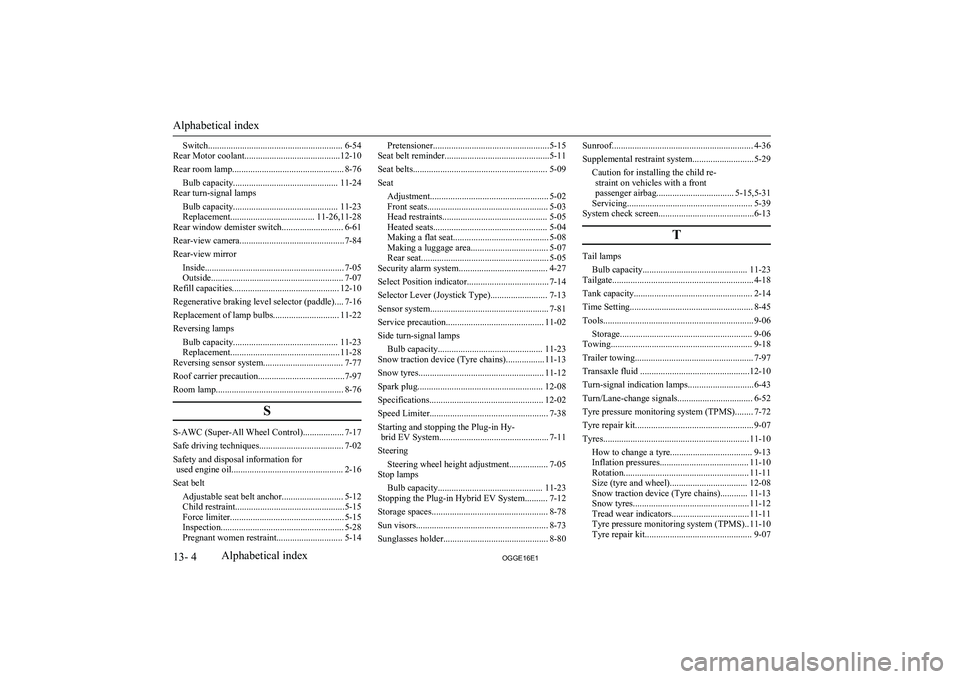
Switch........................................................... 6-54
Rear Motor coolant..........................................12-10
Rear room lamp................................................. 8-76 Bulb capacity.............................................. 11-24
Rear turn-signal lamps
Bulb capacity.............................................. 11-23
Replacement..................................... 11-26,11-28
Rear window demister switch........................... 6-61
Rear-view camera..............................................7-84
Rear-view mirror Inside............................................................. 7-05
Outside.......................................................... 7-07
Refill capacities............................................... 12-10
Regenerative braking level selector (paddle).... 7-16
Replacement of lamp bulbs............................. 11-22
Reversing lamps Bulb capacity.............................................. 11-23
Replacement................................................ 11-28
Reversing sensor system................................... 7-77
Roof carrier precaution......................................7-97
Room lamp........................................................ 8-76
S
S-AWC (Super-All Wheel Control).................. 7-17
Safe driving techniques..................................... 7-02
Safety and disposal information for used engine oil................................................. 2-16
Seat belt Adjustable seat belt anchor........................... 5-12Child restraint................................................5-15Force limiter.................................................. 5-15
Inspection...................................................... 5-28
Pregnant women restraint............................. 5-14
Pretensioner...................................................5-15
Seat belt reminder..............................................5-11
Seat belts........................................................... 5-09
Seat Adjustment.................................................... 5-02Front seats..................................................... 5-03
Head restraints.............................................. 5-05
Heated seats.................................................. 5-04
Making a flat seat.......................................... 5-08
Making a luggage area.................................. 5-07
Rear seat........................................................ 5-05
Security alarm system....................................... 4-27
Select Position indicator.................................... 7-14
Selector Lever (Joystick Type)......................... 7-13
Sensor system.................................................... 7-81
Service precaution........................................... 11-02
Side turn-signal lamps Bulb capacity.............................................. 11-23
Snow traction device (Tyre chains).................11-13
Snow tyres....................................................... 11-12
Spark plug....................................................... 12-08
Specifications.................................................. 12-02
Speed Limiter.................................................... 7-38
Starting and stopping the Plug-in Hy- brid EV System................................................ 7-11
Steering Steering wheel height adjustment................. 7-05
Stop lamps
Bulb capacity.............................................. 11-23
Stopping the Plug-in Hybrid EV System.......... 7-12
Storage spaces................................................... 8-78
Sun visors.......................................................... 8-73
Sunglasses holder.............................................. 8-80Sunroof.............................................................. 4-36
Supplemental restraint system...........................5-29 Caution for installing the child re-straint on vehicles with a front
passenger airbag.................................. 5-15,5-31
Servicing....................................................... 5-39
System check screen..........................................6-13
T
Tail lampsBulb capacity.............................................. 11-23
Tailgate.............................................................. 4-18
Tank capacity.................................................... 2-14
Time Setting...................................................... 8-45
Tools.................................................................. 9-06 Storage.......................................................... 9-06
Towing.............................................................. 9-18
Trailer towing.................................................... 7-97
Transaxle fluid ................................................12-10
Turn-signal indication lamps.............................6-43
Turn/Lane-change signals................................. 6-52
Tyre pressure monitoring system (TPMS)........ 7-72
Tyre repair kit.................................................... 9-07
Tyres................................................................ 11-10 How to change a tyre.................................... 9-13Inflation pressures....................................... 11-10
Rotation....................................................... 11-11
Size (tyre and wheel).................................. 12-08
Snow traction device (Tyre chains)............ 11-13
Snow tyres................................................... 11-12
Tread wear indicators.................................. 11-11
Tyre pressure monitoring system (TPMS).. 11-10
Tyre repair kit............................................... 9-07
Alphabetical index
13- 4 OGGE16E1Alphabetical index